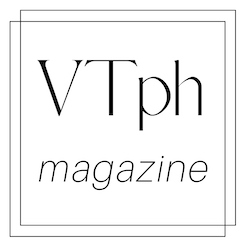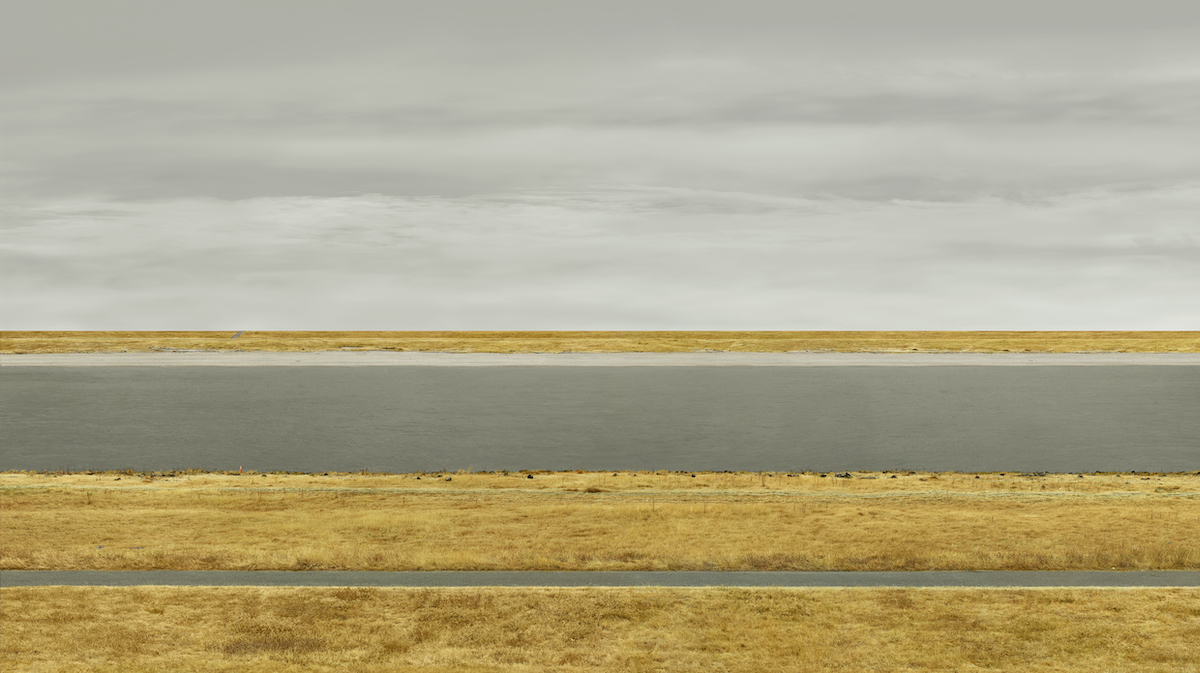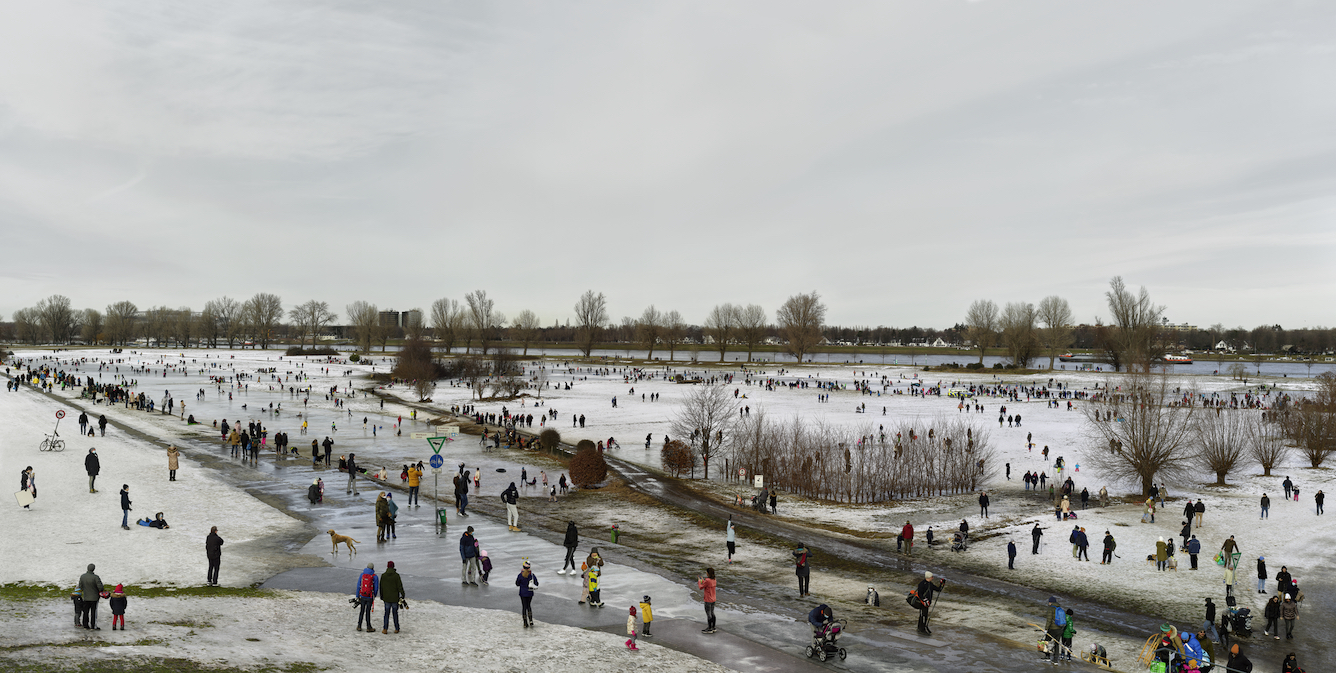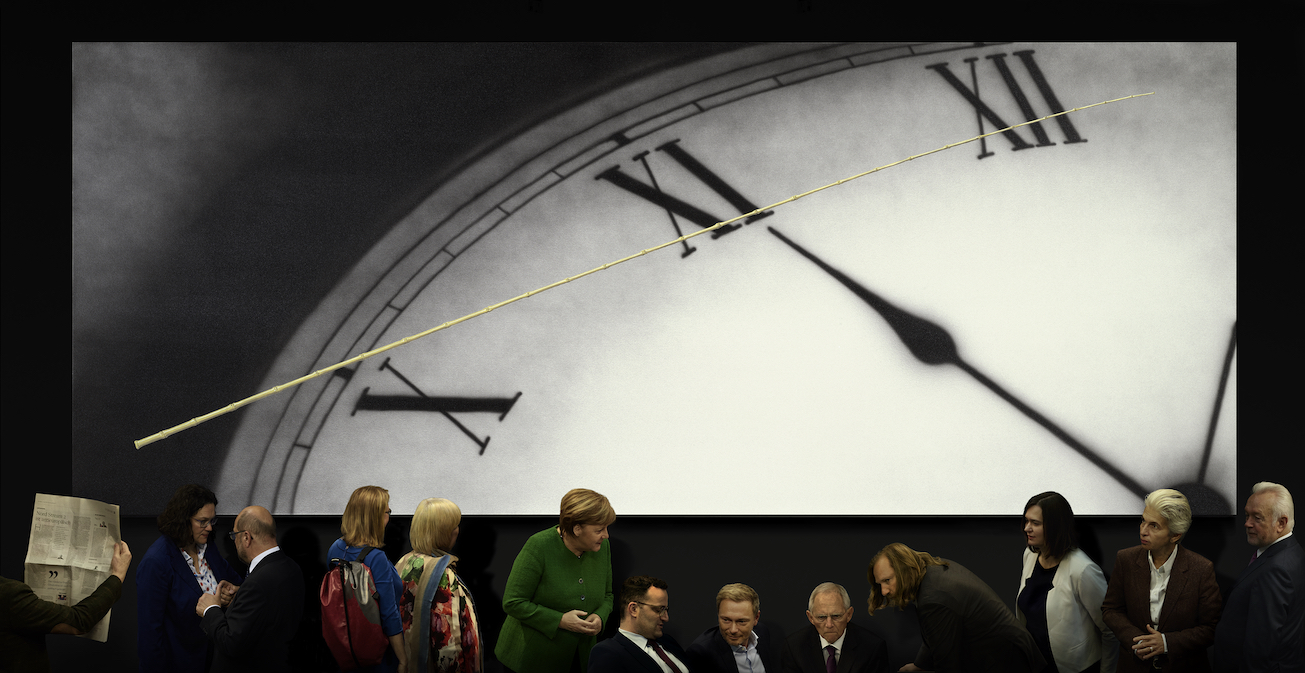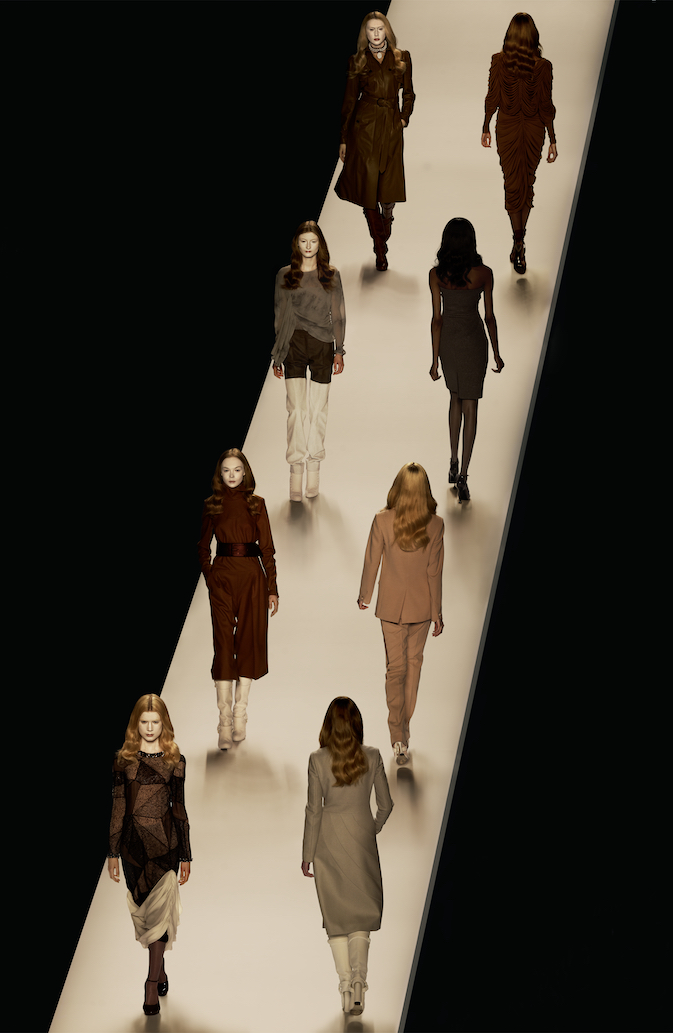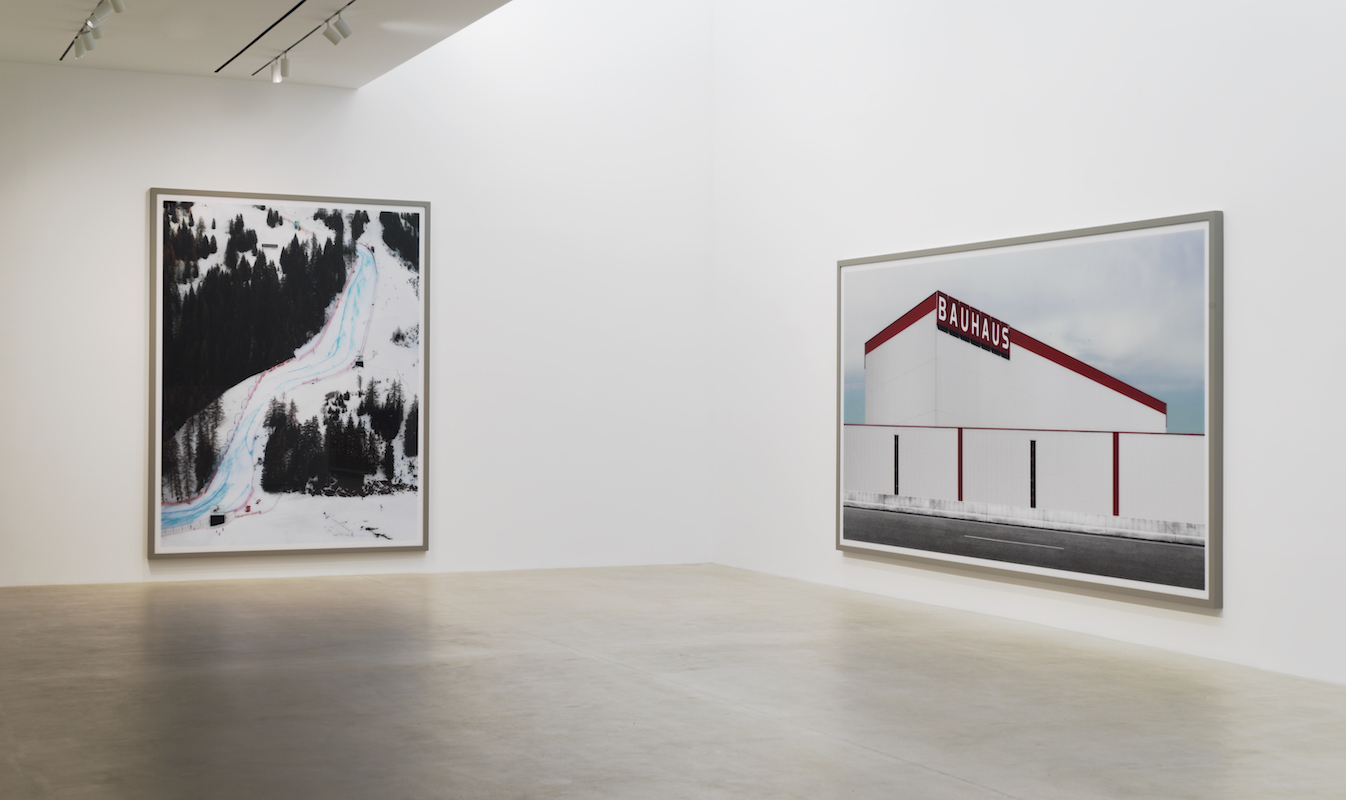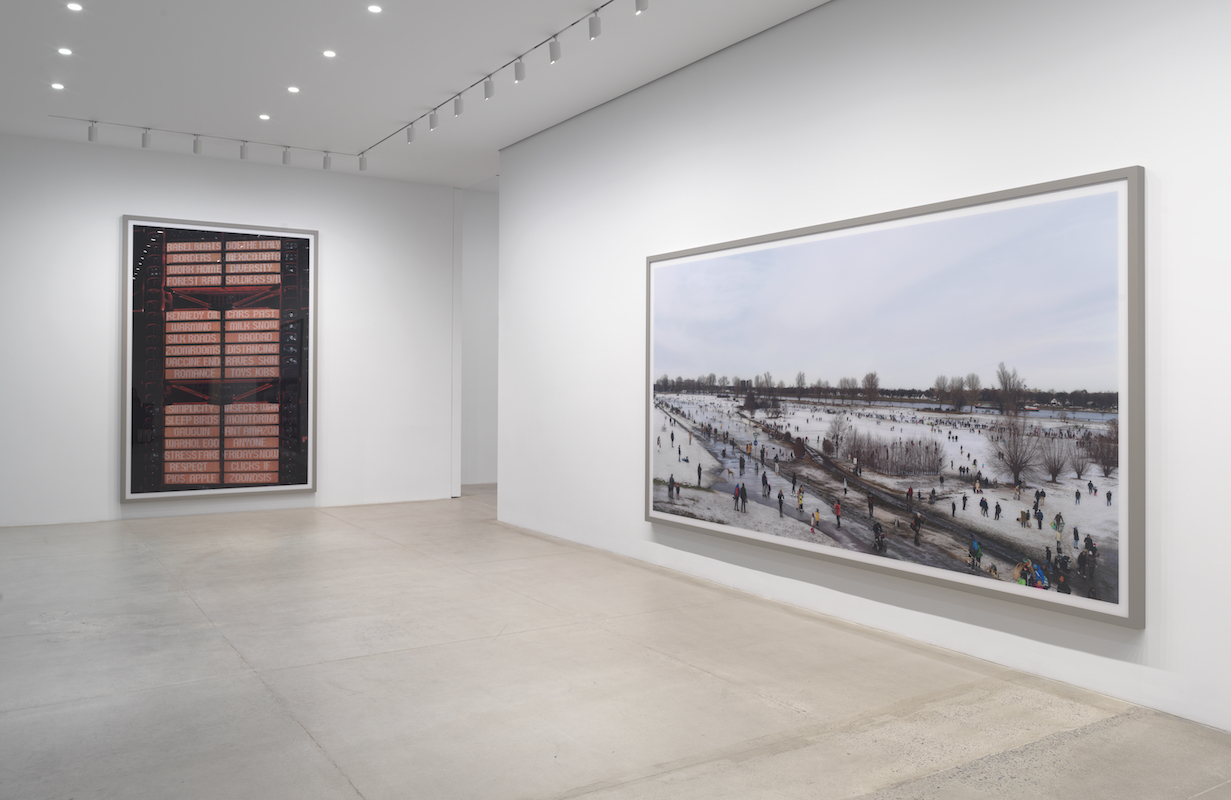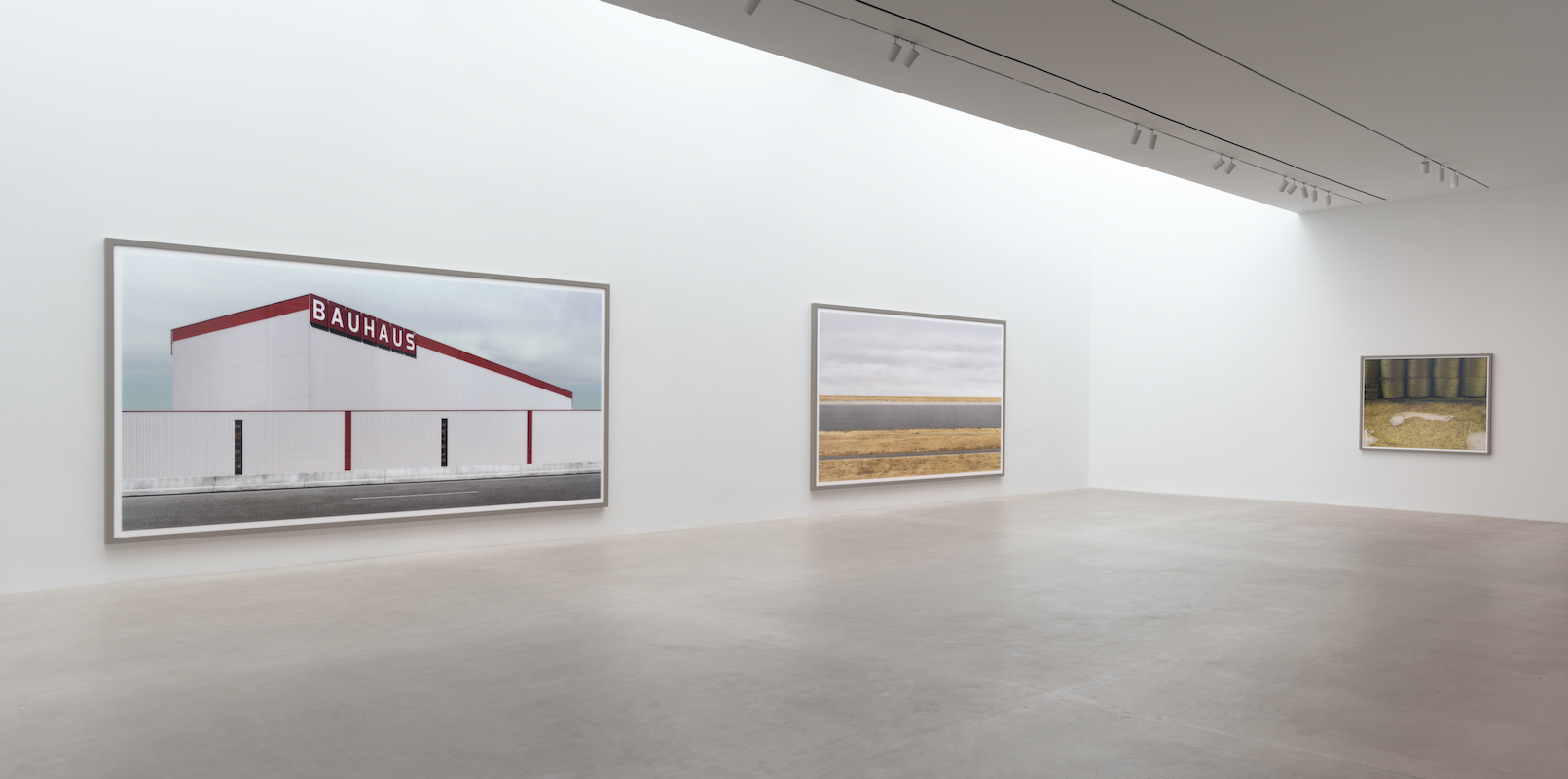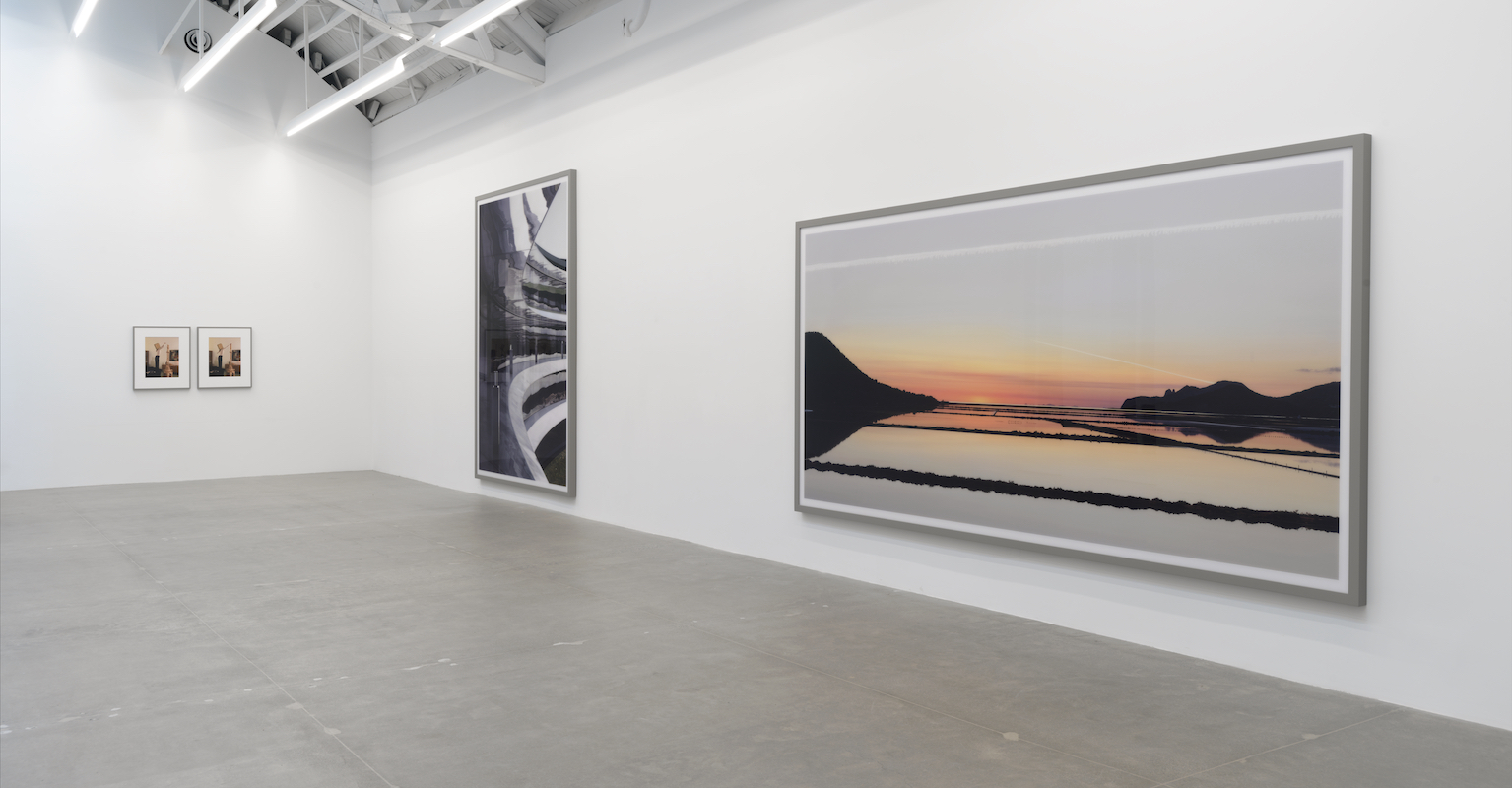Andreas Gursky
On the occasion of an exhibition at Gagosian, New York, Max Dax met with Andreas Gursky to speak with the photographer about his new work. Here, they discuss the consequences of the pandemic on certain works, the roles of techno music and art history in Gursky’s art process, and the necessary balance of beauty and honesty in the contemporary.
Max Dax is a German writer who investigates art, music, and pop culture. As editor-in-chief of the magazines Alert, Spex, and Electronic Beats, Dax has shaped pop journalism in Germany for more than three decades. He curated the recent museum shows Hyper! A Journey into Art and Music in Hamburg’s Deichtorhallen (2019) and Black Album/White Cube in Rotterdam’s Kunsthal (2020). As a musician, Dax is an active member of both the band Brandt Brauer Dax Frick and the art/music collective LAWBF. Together with Luci Lux, he runs the Santa Lucia Gallery of Conversations, Berlin. His first novel, Dissonanz, was published in the spring of 2021.
Whether working from nature or from cities, crowds, and arrays of commercial products, Andreas Gursky makes existing elements into new worlds. Constructed tableaux based on methodical observation, his large-format, high-definition photographs privilege neither foreground nor background, with hyperreal results.
Max Dax: Andreas, your work today increasingly seems to me to be a work of revision. Like Pablo Picasso, who went back through early phases of his work again in his late work, and like Bob Dylan, who constantly rearranges and deconstructs his old songs live on his Neverending Tour, you seem to be working on refinements, clarifications, and variations of earlier images. I think this is clear in Rhein III [Rhine III, 2018], which exists in earlier versions from 1996 and 1999.
Andreas Gursky: I guess you’re right. The works to be exhibited at Gagosian in New York, especially, refer strongly in part to existing pictures. In total, I’m showing seven previously unpublished large-format works, as well as some works from the last two years. It’s important to me that Politik II [Politics II, 2020] is included. It refers not so much to my early work as to a more recent one, Rückblick [Review], created in 2016. For Politik II I arranged the images of thirteen politicians of the German Bundestag in front of a painting by Ed Ruscha. Only later did I notice that Leonardo da Vinci also painted thirteen people in The Last Supper. But I didn’t intend that analogy.
MD: Let’s talk about the new work. I’d like to highlight Eisläufer [Ice skaters, 2021], which, for me, recalls your early Dutch-landscape photography.
AG: The initial photo was taken exactly a year ago. Last February we had a massive cold snap after a flood in Düsseldorf, in the midst of the coronavirus pandemic. The entire floodplains of the Rhine, the Rheinauen, were flooded, and then the cold snap iced them over, along with snowfall. Many Düsseldorfers took advantage of the moment and took walks on the icy Rhine meadows, and I also played ice hockey there with friends. Day by day it got more and more crowded, and I decided to capture this amazing scene in a photo. The finished picture recalls [Pieter] Brueghel, inevitably, but above all it’s a snapshot of that pandemic winter: people are wearing masks and keeping their distance from each other. This is a completely new picture, and it will be shown in New York for the first time, but as you say, it’s in the canon of my early landscape pictures.
MD: Unlike Brueghel’s paintings, Eisläufer is gigantic in size.
AG: Yes, it measures 7 by 13 1/2 feet, many times larger than any Brueghel. But the real difference lies elsewhere, in terms of content: the imagery suffers from sickness. On the one hand, people are wearing pandemic masks. On the other hand, on the day I took the photo the snow began to melt, the landscape was in the process of disappearing. The following day the scenery had collapsed because of a sudden warm snap.
MD: What other works will debut in New York?
AG: Streif [2021] is very important to me: it shows the Streif downhill ski slope in Kitzbühel, Austria, in January 2020, shortly before the outbreak of the pandemic. In earlier years I’d regularly been in Thailand in January, but that year I finally found myself in Kitzbühel, so I photographed the Streif. The picture shows the slope in long shot. Anyone who has ever been there will immediately recognize the ski track, but parts of the picture are fictitious—I partly re-created the track on the computer. It’s because I missed photographing the Streif year after year that this picture is so close to my heart. It just took me a very, very long time to finally be able to take it.
MD: Almost all of the images you’ll be exhibiting in New York include portents of a period of upheaval. The terms “climate change” and “the Anthropocene” seem to me to run through the pictures like a red thread. The Streif slope exists not least through the use of snow cannons, an obvious environmental sin.
AG: Streif shows the hubris of humanity—as, incidentally, did the TV images of the downhill slopes at the 2022 Winter Olympics in China, where snow cannons painted white slopes on anthracite-colored mountains. Whether in Kitzbühel or in Yanqing, all of these tracks are somewhat similar in their iconography: they’re always white ski slopes bordered on their fringes by red track boundaries and featuring a blue-marked inner track. Given their identical structure, we may be able to speak of a visual vocabulary defining these slopes.
MD: One new work, V&R II [2022]—again a reworking of an earlier work, V&R of 2011—features fashion models on a catwalk. At first glance one might think it falls apart from the group because it shows a fashion show. But in the context of the other pictures, you can read a lot into it.
AG: The new work is much more stylized than the 2011 picture: it shows only a beige stripe, the catwalk, on a black background, with the models walking on it. The picture is very two-dimensional and therefore also very abstract. Again, I used old material from ten years ago in Paris.
MD: You probably have a lot of unused photos on your hard drives.
AG: It often takes me a long time to really get to a picture. I have a lot of photos in my library, and when I take photos, I know that I’m not forced to translate these photos into images immediately. Pictures need time and distance. And I’m patient. I didn’t travel during the pandemic and had the time and leisure to review my archive of images.
MD: When a photographer presses the shutter, they freeze a moment in time. That’s our idea of the photographer. But you let images rest, bring them out into the daylight years later and recompose them—you turn them into new images that never existed in reality. In this sense, as a photographer and an artist, how do you think about concepts like the past and the present?
AG: I have to think about that for a moment. Actually, every tense can appear in my pictures. The present is always captured in them. In Eisläufer I don’t just quote Brueghel, that is, the past; the picture needs a clear reference to the present. One could perhaps speak of a sort of dismantling of homage here. With Eisläufer, you can clearly see that it was created in the ’20s of this century; you can even name the year almost exactly, through the people’s masks and clothes. But the compositional aspect transcends time. And of course I take that freedom as an artist—even though I’m working with photography, I fall back on compositional schemes that already exist in art history. In theory there’s a canon of expression that artists fall back on again and again. I don’t believe that as an artist you always have to completely reinvent the wheel—instead, you have to fill it with new life.
MD: In that sense, when you revisit and rework your images, they’re images about images. And about third parties: if Eisläufer refers to Brueghel, Bauhaus [2020] refers to Ruscha’s gas station pictures and Rhein III refers to Barnett Newman. I’m not the first to see that in your photography.
AG: Sure. Ruscha, of course, is an artist I admire and always have in the back of my mind. But honestly, when I did Toys ’R’ Us [1999], I hadn’t really discovered Ruscha for myself yet. Only later did I consciously start to refer to him.
MD: With your pictures in general, but also with the selection of new works in the show, you position yourself as a chronicler of the late twentieth and early twenty-first centuries. One of the three pictures in the Hong Kong Shanghai Bank series [2020] shows that bank’s façade, which has a gigantic LED wall mounted on it, in a moment of broadcasting pause. The other two images imagine possible screenings of this LED wall: an image of the umbrella protests in Hong Kong and a series of English-language terms, scraps of words recalling Jenny Holzer’s Truisms [1977–79] but remaining strangely apolitical.
AG: I do see myself as a chronicler. My pictures try to encapsulate our time. I photographed the Hongkong Shanghai Bank in 1994. Encountering this building again twenty-five years later, I saw that the façade is now completely covered with an LED carpet. They “curate” this LED wall with quite banal narratives: at Easter, for example, they show Easter bunnies, Easter eggs, and so on. So I came up with the idea of displaying my own narratives on this wall. I waited for a moment when the wall briefly glowed a complete monochrome, an orange. This image became my basis for working with the building independently. If I were an installation artist, I might have contacted the bank and asked whether I could contribute to this wall with my own stories, though realistically, of course, I’d never have gotten permission for that idea. For the first step, it was obvious to me to cover the wall with a picture of the umbrella protests, not least because they took place right in front of the building.
MD: In the second picture the LED wall shows terms like “Romance,” “Vaccine End,” “Goethe Italy,” and “Clicks If.” These text fragments remind me of concrete poetry. But they’re not from Holzer, or are they?
AG: I met Jenny two years ago in Seoul and l considered asking her to collaborate. But then I said to myself, Come on, try it yourself! I originally wanted to use only words created in the pandemic era, but I soon found that approach too narrow and I opened up the spectrum to other terms.
MD: In general, what roles do language and typography play in your work? Certainly not as dominant as with Ruscha, but Amazon [2016] makes prominent use of the perseverance slogans “Work Hard,” “Have Fun,” and “Make History.”
AG: But those slogans are actually on the wall on-site, I didn’t write them. There are a lot of management slogans like that at Amazon.
MD: To make your work, you travel constantly around the world. To what extent does travel influence your pictures?
AG: It used to be more important. I used to use what I found on location much more as a source of inspiration, but during the two years of the pandemic I almost never left my studio, and here in Düsseldorf I have my extensive image archive to draw on. I could keep doing that for a very long time. So I’m no longer dependent on travel, but if I come across an event or a place that captivates me on the Internet or in the media, of course I go there. Unlike Thomas Ruff, who no longer touches the camera, it’s still important to me to take photographs myself. I create my own material, not least because my pictures are so large. I show a great deal of detail in my pictures, so that you can read a lot in them, and you can only do that if you take your own photographs at high resolution.
MD: In a recent conversation with Jeff Wall, you mentioned that you admired your father for his drawing talent. Is that why you keep approaching painting in your pictures?
AG: There was definitely a painterly phase, but in all honesty, it’s already over again. In 2012–13 I had an exhibition at the Kunstpalast in Düsseldorf, for which they published my catalogue Bangkok. In the Bangkok images, I addressed painting very strongly, not only in the works themselves but in conversations and interviews. Since then, though, I’ve increasingly gone back to the specifically photographic. Of course the Bangkok pictures are certainly photographs too, clearly showing objects floating in water, but at the same time there’s an obvious and deliberate analogy with Abstract Expressionism. And with that series I felt I’d reached a limit. I didn’t want to cross that line into becoming an abstract stylist, becoming untrustworthy.
MD: But you moved into the realm of the painterly long before Bangkok. I think again of the Rhein pictures, and also of your untitled pictures of tulip fields in the Netherlands. If you squint a little as you look at those works, you think you see brushstrokes, painted surfaces.
AG: Exactly—in those works there’s a clear formal similarity to Mark Rothko. But I came to the point in the painterly images where, in the process of editing, I often asked myself how arbitrarily I could and might place image information within the framework of a conceptual dictate. A concrete photograph, on the other hand, is the opposite of arbitrary.
MD: You say that some of your pictures remind you of the painting of Rothko, Newman, and Ruscha. Do you collect painting?
AG: Sure, I collect art—sculpture, painting, and of course photography.
MD: Has being able to look regularly at paintings you’ve acquired changed the way you look at painting?
AG: Certainly. In my studio, I look every day at a very early black-and-white painting by Gerhard Richter. It’s one of his very few that, because they’re painted gesturally, seem abstract but actually refer to a photographed landscape. It’s basically a gray painting, and in bad light it just looks gray. In bright daylight, though, you see an insane amount of gradation. Every brushstroke is precise and deliberate.
MD: What can you tell me about Salinas [2021], another new photograph? It stands out because it really shows beauty—a breathtaking starry sky and a natural spectacle, salt flats.
AG: That’s probably the most important work for me right now because it may open the door to a new approach, we will see. My family’s second home is on the island of Ibiza, we spend a lot of time there every year. But I’ve found it difficult to find motifs there until I saw this one sunset by Las Salinas. These salinas are natural facilities where seawater is channeled into individual fields where it evaporates and becomes salt. The process was brought to Ibiza by the Phoenicians many centuries ago. So this is an ancient landscape, but an artificial one, and it’s the foreground in my picture. The sun has already set, and over this landscape, which is impressive in itself, a chromatically colored sky opened up one evening. I simply had to photograph it. It wasn’t kitschy; it reminded me of Éric Rohmer’s Le rayon vert [The Green Ray, 1986]. And after I photographed this surreal image that presented itself to me, it once again lay in the proverbial drawer for two or three years. I actually wondered for a long time whether it was appropriate to compose a simply beautiful image in a time as politically troubled as the one we live in.
MD: And?
AG: I searched for a long time for something to transcend this image and place it in the present moment. It hung here in my studio for a long time so I could look at it. I mentioned my conflict with the inherent beauty of the picture to a curator who visited me in the studio once. She said that the picture didn’t need anything more—after all, there are beautiful moments, poetic situations, in our world. That set something in motion in me. But I still wanted to add a detail to the picture, the contrails of two airplanes flying through this natural spectacle. So I started to look at contrails. I learned in Bernd and Hilla Becher’s class [at the Kunstakademie Düsseldorf] how to approach motifs systematically. What do contrails actually look like? What is the range here? For weeks I observed and photographed contrails in the sky—and each one looks totally different.
I reduced the selection to two variants. One looks like a transparent, jellyfishlike thread. Taken on its own, it’s a completely abstract image, one would never think an airplane had produced it. The other is more tangible, more tactile. It’s like a textured cord. By incorporating a contrail like that into an image of perfect beauty, I’m toying with the tension between sublimity and destruction. We all know that smog can make a sunset look picturesque. To photograph such an image is to encapsulate its beauty while knowing that the balance of this landscape is hanging by a thread and could tip over if environmental destruction continues to advance. In all my images I try to allow both, the threat and destruction but also the beauty.
In this way I may also prevent my images from being understood too quickly. A clearly accusatory image with a political message is not my thing, because the image then loses its appeal. It needs a form, a coding.
MD: As a curator, I have a personal concern with the tension between music and art. So I’m interested in the influence of music in your work. You’ve photographed concerts and raves, but you’ve never photographed Kraftwerk. Wouldn’t that be an obvious next picture of yours?
AG: Ralf Hütter is my friend and we exchange ideas more or less every day. Occasionally I visit him in the recording studio, but so far no picture has come to mind. Instead, we discovered the Bauhaus distribution center in Krefeld on our bike tours, which led to Bauhaus.
MD: When did music start to play a role in your work?
AG: It started around the time of Union Rave. That was the period of acid house, when techno started. Shortly after that I attended the first Mayday rave in Dortmund.
MD: That picture is dated 1995.
AG: Yes, but again, the picture was preceded by a phase when the photos were lying around. The Union Rave was a big, influential techno rave at the Philipshalle in Düsseldorf. For long stretches of the ’70s I listened to rock, from Pink Floyd to Jimi Hendrix to the Doors. Then later, psychedelic rock like Amon Düül, Tangerine Dream, Can, and Soft Machine. But through photography, and that’s why I love my profession more than anything, I eventually wanted to photograph dance floors. I not only took my first dance floor picture at the Union Rave, I also came into contact with house and techno for the first time. I was immediately struck by it. So afterwards I went to [the] Mayday [rave], where I became friends with [the DJ] WestBam. Through my regular visits to raves, techno began to play an increasingly important role in my life. Exactly twenty-five years ago I met Sven Väth in Thailand, and he still has a significant influence on my taste in music today.
MD: Techno music essentially follows one rule: same but different. Techno tracks follow strict formal guidelines, but within those guidelines the microstructures of the tracks change continuously. That understanding can also be applied to the production of art, like a matrix—that’s what I mean when I talk about the invisible influence of music on visual art. That was the theme of my exhibition Hyper! A Journey into Art and Music, at the Deichtorhallen, Hamburg, in 2019. You participated in the exhibition with a Mayday, a Cocoon, and a Madonna picture.
AG: I definitely consider musical analogies in the composition of many of my works. You mentioned the tulip photographs earlier—the patterns I laid out the tulip fields in are like the structure of a techno track. It’s a very repetitively structured image, like techno.
MD: So you translate music into images?
AG: Yes. Also, when I’m alone in the studio on Mondays, Wednesdays, and Fridays, I always listen to loud music. On the other days I have my people present, working through whatever needs to be worked on, but on the days between, I have the studio to myself. And as far as music goes, I’m really spoiled. Sven Väth got me on the right track there. By the way, while working on the rave pictures I noticed more and more that I could photograph the dancers either as a densely packed, raving mass or on a less crowded dance floor. In the first case, the images evoke a surging landscape, in which case they fall into the tradition of the German Romantics. But in the second, such as Mayday IV [2000], individual people emerge. You see their clothes and maybe their shoes, and everyone has space around them. There’s always talk around techno music of “deindividualization,” but when I look at my pictures, I see hundreds of individuals, not a collective of the masses.
Artwork © Andreas Gursky/Artists Rights Society (ARS), New York
Andreas Gursky, Gagosian, 541 West 24th Street, New York, May 5–July 29, 2022
This interview is republished with the kind permission of Gagosian Gallery and it originally appeared in Gagosian Quarterly, Summer 2022, pp. 36–45
